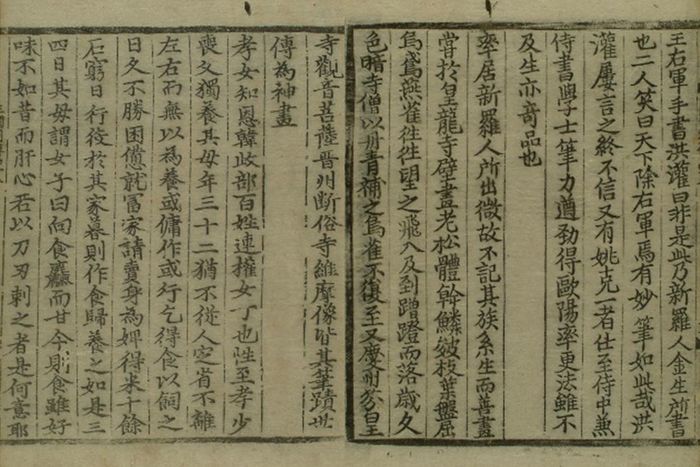(2017Translation) 率居
| Primary Source | ||
|---|---|---|
 |
Title | |
| English | Solgŏ | |
| Chinese | 率居(Solgŏ) | |
| Korean(RR) | 솔거 | |
| Text Details | ||
| Genre | ||
| Type | ||
| Author(s) | ||
| Year | ||
| Source | ||
| Key Concepts | ||
| Translation Info | ||
| Translator(s) | Participants of 2017 Summer Hanmun Workshop (Intermediate Training Group) | |
| Editor(s) | ||
| Year | 2017 | |
목차
- 1 Original Script
- 2 Translation
- 2.1 Student 1 : Sanghoon Na
- 2.2 Student 2 : (Write your name)
- 2.3 Student 3 : (Write your name)
- 2.4 Student 4 : (Write your name)
- 2.5 Student 5 : (Write your name)
- 2.6 Student 6 : (Write your name)
- 2.7 Student 7 : (Write your name)
- 2.8 Student 8 : Bryan Sauvadet
- 2.9 Student 9 : (Write your name)
- 2.10 Student 10 : (Write your name)
- 2.11 Student 11 : (Write your name)
- 2.12 Student 12 : (Write your name)
- 2.13 Student 13 : (Write your name)
- 2.14 Student 14 : (Write your name)
Original Script
Translation
Student 1 : Sanghoon Na
Solgŏ was a man of Silla kingdom. His family background was so insignificant that there was no record of his genealogy. From his birth he was good at drawing. Once on the wall of Hwangryong Temple(lit. Yellow Dragon Temple) he drew an old pine tree. Tree trunks had scaly, wrinkled barks and branches and leaves were crooked and twisted. Crows, hawks, swallows, and sparrows occasionally observed it and flew into [it]. [But when] lighting on, they slipped and fell [to the ground]. As the many years passed by, the color faded to dark gray. A monk at the temple painted it over with red and blue pigments. But the crows and sparrows never came back. And the Avalokiteśvara of Punhwang Temple in Kyŏngju and the Vimalakirti Image of Tansok Temple in Chinju are all traces of his brushes, which have been transmitted for generations as legendary paintings.
Student 2 : (Write your name)
Student 3 : (Write your name)
Student 4 : (Write your name)
Solgŏ [was a] a man of Silla. The place he was from was obscure, [and] for this reason [people] did not record his clan or geneaology.
[From] birth [it] pleased [him] to draw. Once [he] drew an old pine tree on the wall of Hwanglong Temple.
Its body and branches were dabbed with scales and wrinkles, its branches and leaves were coiled and crooked. Crows and kites, swallows and sparrows often saw [it from afar] and flew in, [and] suddenly arriving, scraped and smacked [against the wall and] fell.
Years passed [and the tree's] color dimmed, [so] a temple monk used pigments1 to patch it, and birds did not again reach [it]
The Boddhisatva Kwannŭm2 painting in Punhwang Temple in Gyŏngju and the Vimalakirti3 painting in Dansok Temple in Chinchu all also [bore] the mark of his brush, [and] the scholars of his generation took these to be legendary paintings.
1 The colors that make up the traditional colors collectively termed tanch'ŏng (丹靑).
2 A Buddhist deity (C: Guanyin; J: Kannon).
3 A Buddhist layman who is the main figure in the Vimalakirti Sutra, composed in the second century CE.
Student 5 : (Write your name)
Student 6 : (Write your name)
Student 7 : (Write your name)
Student 8 : Bryan Sauvadet
Solgŏ was a person from Silla state. Nobody knew his background origins, and there were any records of his family linage. From birth, he was dexterous at painting. Once, He had painted old pin trees on the walls of the Hwangnyong-sa: the monastery of the dragon emperor. The major branches and trunks cracked the little branches and leaves twisted between each others. Crows, swallows, sparrows and various birds, often times, they flew and crashed into the walls. The time pasted, and the colors had darkened. So the monks fixed it with vermillion and blue pigments, and the crows and the other birds never returned into the walls of the monastery. Moreover, [through] the bodhisattva Avalokiteśvara on the Punhwang-sa: the monastery of imperial fragrance, in Kyŏngju; and the representation of the lay practitioner Vimalakīrti at the Tansok-sa: the monastery of the Samatā, in Chinju; everybody traced his brush. Generations after generations, people transmitted that he was a holy painter
Student 9 : (Write your name)
Student 10 : (Write your name)
Student 11 : (Write your name)
Student 12 : (Write your name)
Student 13 : (Write your name)